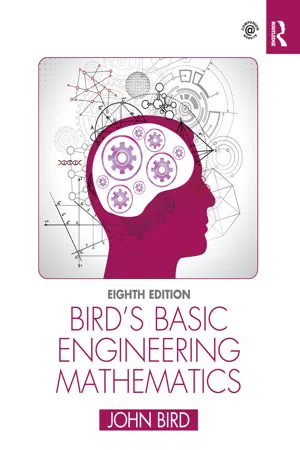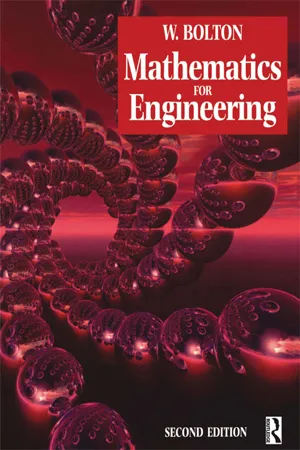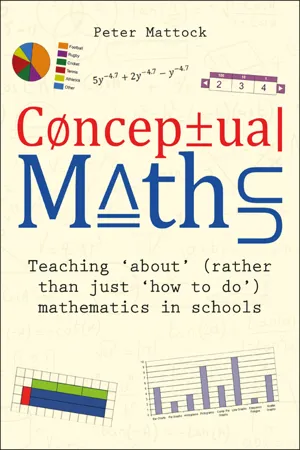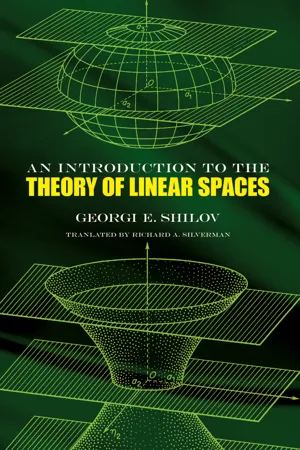Mathematics
Volume of prisms
The volume of a prism is the measure of space enclosed by the prism. It is calculated by multiplying the prism's base area by its height. For a rectangular prism, the volume formula is V = lwh, where l is the length, w is the width, and h is the height. This concept is fundamental in geometry and is used to solve real-world problems involving three-dimensional shapes.
Written by Perlego with AI-assistance
Related key terms
9 Key excerpts on "Volume of prisms"
- Richard Lehrer, Leona Schauble(Authors)
- 2023(Publication Date)
- Routledge(Publisher)
Shortly after these initial qualitative explorations, students begin to find and compare volumes by employing units. As with length and surface area, an important conceptual achievement in understanding volume is coming to understand the properties of units of volume. Students recognize that the units used to measure must be the same or, if not, distinctly labeled, and units need to tile, or completely fill, the volume being measured. Students’ work at this level begins with rectangular prisms. Later, when they encounter other 3-D shapes (such as cylinders), the nature of units may need to be reconsidered, because students have a tendency to favor units that bear a perceptual resemblance to the figure being measured. For example, they may be drawn to using beads to fill the volume of a cylinder because both the beads and the cylinder are “curvy.” However, students usually recall readily that they have already resolved this issue of resemblance in the context of area and quickly reject the solution based on similarity because it does not meet the criteria of avoiding both “gaps” and “overlaps” of measure so that units entirely fill the three-dimensional space.As they first attempt to measure the volume of rectangular prisms, students find volume by counting unit cubes in structures in which all the cubes are visible. Much of the instruction in the early grades is aimed toward helping students differentiate the area of 3-D figures from their volume, but also to perceive the relations between these two attributes in any three-dimensional shape. In Volume unit 1 of Measuring and Visualizing Space, students compare the surface areas of three different “apartment buildings” (that is, prisms) constructed of interlocking cubes. Each building is composed of 12 cubic “apartments” with the following dimensions: 1 × 1 × 12 cubes, 2 × 2 × 3 cubes, and 6 × 1 × 2 cubes. Surface area is contextualized as the windows, roof, and footprint of the building. Students next compare the volume enclosed or occupied by each building—that is, the number of “apartments” that each building holds. In this introductory task, the context supports children in differentiating surface area (e.g., the number of windows, roof, and building footprint) from volume (e.g., the total number of apartments enclosed in each building). Students also find that even though the surface areas of the three buildings vary, their volume measures are the same. The lesson was originally designed for classes of second-grade students, but it can also serve as an entrée to volume measure in later grades.- eBook - ePub
- John Bird(Author)
- 2021(Publication Date)
- Routledge(Publisher)
The shape of the end is used to describe the prism. For example, there are rectangular prisms (called cuboids), triangular prisms and circular prisms (called cylinders). On completing this chapter you will be able to calculate the volumes and surface areas of rectangular and other prisms, cylinders, pyramids, cones and spheres, together with frusta of pyramids and cones. Volumes of similar shapes are also considered. 28.2 Volumes and surface areas ofcommon shapes Cuboids or rectangular prisms A cuboid is a solid figure bounded by six rectangular faces; all angles are right angles and opposite faces are equal. A typical cuboid is shown in Fig. 28.1 with length l, breadth b and height h. Figure 28.1 V o l u m e o f c u b o i d = l × b × h and s u r f a c e a r e a = 2 b h + 2 h l + 2 l b = 2 (b h + h l + l b) A cube is a square prism. If all the sides of a cube are x then V o l u m e = x 3 a n d s u r f a c e a r e a = 6 x 2 Problem 1. A metal cuboid container has dimensions of 12 cm by 4 cm by 3 cm. Determine (a) its volume and (b) its total surface area The cuboid is similar to that in Fig. 28.1,. with l = 12 cm, b = 4 cm and h = 3 cm Volume of cuboid = l × b × h = 12 × 4 × 3 = 1 4 4 c m 3 S u r f a c e a r e a = 2 (b h + h l + l b = 2 (4 × 3 + 3 × 12 + 12 × 4) = 2 (12 + 36 + 48) =[--=PL. GO-SEPARATOR=--]2 × 96 = 1 9 2 c m 2 Problem 2. An oil tank is the shape of a cube, each edge being of length 1.5 m. Determine (a) the maximum capacity of the tank in m 3 and litres and (b) its total surface area ignoring input and output. orifices Volume of oil tank = volume of cube = 1.5 m × 1.5 m × 1.5 m = 1.5 3 m 3 = 3. 3 7 5 m 3 1 m 3 = 100 cm × 100 cm × 100 cm = 10 6 cm 3. Hence, volume of tank = 3.375 × 10 6 cm 3 1 litre = 1000 cm 3, hence oil tank capacity = 3.375 × 10 6 1000 litres = 3 3 7 5 litres Surface area of one - eBook - ePub
- John Bird(Author)
- 2019(Publication Date)
- Routledge(Publisher)
Chapter 14 Volumes of common solidsWhy it is important to understand: Volumes of common solidsThere are many practical applications where volumes and surface areas of common solids are required. Examples include determining capacities of oil, water, petrol and fish tanks, ventilation shafts and cooling towers, determining volumes of blocks of metal, ball-bearings, boilers and buoys, and calculating the cubic metres of concrete needed for a path. Finding the surface areas of loudspeaker diaphragms and lampshades provide further practical examples. Understanding these calculations is essential for the many practical applications in engineering, construction, architecture and science.At the end of this chapter, you should be able to:- state the SI unit of volume
- calculate the volumes and surface areas of cuboids, cylinders, prisms, pyramids, cones and spheres
- appreciate that volumes of similar bodies are proportional to the cubes of the corresponding linear dimensions
14.1 Introduction
The volume of any solid is a measure of the space occupied by the solid. Volume is measured in cubic units such as mm3 , cm3 and m3 .This chapter deals with finding volumes of common solids; in engineering it is often important to be able to calculate volume or capacity, to estimate, say, the amount of liquid, such as water, oil or petrol, in differently shaped containers.A prism is a solid with a constant cross-section and with two ends parallel. The shape of the end is used to describe the prism. For example, there are rectangular prisms (called cuboids), triangular prisms and circular prisms (called cylinders).On completing this chapter you will be able to calculate the volumes and surface areas of rectangular and other prisms, cylinders, pyramids, cones and spheres. Volumes of similar shapes are also considered.14.2 Calculating volumes and surface areas of common solids
Science and Mathematics for Engineering. 978-0-367-20475-4, © John Bird. Published by Taylor & Francis. All rights reserved.14.2.1 Cuboid or rectangular prism
- eBook - ePub
- W Bolton(Author)
- 2012(Publication Date)
- Routledge(Publisher)
5 A pipe has an internal diameter of 40 mm, an external diameter of 50 mm and a length of 6.0 m. Determine the volume of metal required for the pipe.6 Determine the volume of a prism when (a) the base is 4.0 cm square and its height is 6.0 cm, (b) the base is a a rectangle 2.5 cm by 2.0 cm and its height is 5.0 cm, (c) the base is circular of diameter 4.0 cm and its height is 8.5 cm.2.3.2 Frusta of prisms
If a prism is cut by two planes inclined to one another, the solid contained between them is called a frustum of the prism. For example, Figure 2.14 shows a frustum of a cylinder. The average height of the cylinder is ½(h1 + h2 ) and so its volume is:volume = ½(h1 + h2 ) × πr2Figure 2.14 Frustum of a cylinderThe surface area of the curved surface is the circumference of the transverse section multiplied by the mean height (Figure 2.15 ), i.e.area = 2πr × ½(h1 + h2 )Figure 2.15 Surface area offrustrumThe volume of the frustum of any triangular prism is: volume = average length of lateral sides × area of transverse sectionExample A frustum of mean length 1.20 m is cut from a cylindrical bar of diameter 0.20 m. Determine its volume and surface area of the curved surface.RevisionVolume = 1.20 × 1/4Π × 0.202 = 0.038 m2Surface area of curved surface = 1.20 × π × 0.20 = 0.75 m27 Determine the volume of the frustum of the cylinder shown in Figure 2.16 . All dimensions are in millimetres.Figure 2.16 Revision problem 72.3.3 Pyramids
A solid with a plane end and straight sides meeting in a point is called a pyramid. The shape of the plane end may have any plane shape, thus it may be rectangular, triangular, hexagonal, circular, etc. Figure 2.17 shows some examples. When the plane end is circular, as in Figure 2.17(c) , the term cone is used.Figure 2.17 PyramidsThe term right pyramid is used when the apex is vertically above the centre of the base, otherwise the term oblique pyramid is used. If we think of a right pyramid as built up from a number of layers, then sliding successive layers over another generates an oblique pyramid will the same volume (Figure 2.18 - eBook - ePub
- Andre Castagna(Author)
- 2021(Publication Date)
- Barrons Educational Services(Publisher)
The prism shown in Figure 12.1 above is a rectangular prism. The edges between the lateral faces are called lateral edges. The height of the prism is the perpendicular distance between the two bases. Prisms are named based on the type of polygons that make up the bases.Figure 12.1 Parts of a prismA prism can also be classified as right or oblique. A right prism, such as the one in Figure 12.1, has its lateral edges perpendicular to the bases and the bases are aligned one over the other. An oblique prism has lateral edges that are not perpendicular to the bases as shown in Figure 12.2 above. Note that the height in an oblique prism is still the perpendicular distance between the bases.Figure 12.2 Oblique prismVolume of a Prism
Volume (V) = B · hwhere B is the area of the base and h is the height.Since the base can be any polygon, the volume formula is in terms of the area of the base B. When calculating the volume of a prism, the first step is to identify the bases and determine the correct area formula.Example
Find the volume of the right triangular prism in the accompanying figure.Solution: The bases of the prism are the two triangles. So use the formula for the area of a triangle to find B. The base of the triangle is the 6 cm dimension, and the height of the triangle is 8 cm.Now apply the volume formula for the cylinder. The height of the prism is the 12 cm distance between the two triangles.Math Fact
When working with prisms be careful not to confuse the height of the polygonal base with the height of the prism. For example, a prism with a 10 cm height may have a triangular base whose height is 4 cm. The 4 cm height of the triangle is used in the area formula to calculate the area of the triangular base. The 10 cm height of the prism is used in V = Bh to calculate the volume of the prism.Circular Cylinders
A circular cylinder is a solid figure with two parallel and congruent circular bases and a curved lateral surface. The height is the perpendicular distance between the bases. As with the prisms, cylinders can be right or oblique. Figure 12.3 shows each type of cylinder. - (Author)
- 2023(Publication Date)
- Kaplan Test Prep(Publisher)
x, are needed to build the box?- 5x2
- 6x2
You need to know this:
Three-dimensional (3D) shapes are also called solids. There are several different types of solids that might appear on test day—rectangular solids, cubes, cylinders, prisms, spheres, cones, and pyramids—and knowing their structures will help you on test day.The following diagram shows the basic anatomy of a 3D shape:A face (or surface) is a two-dimensional (2D) shape that acts as one of the sides of the solid. Two faces meet at a line segment called an edge, and three faces meet at a single point called a vertex.Volume
Volume is the amount of 3D space occupied by a solid. Volume is analogous to the area of a 2D shape. You can find the volume of many 3D shapes by finding the area of the base and multiplying it by the height: (V = Abase × h). In the table of formulas, the pieces that represent the areas of the bases are enclosed in parentheses.Rectangular Solid Cube Right Cylinder V = (l × w) × h V = (s × s) × s = s3 V = (π × r2 ) × h These three 3D shapes are prisms. Almost all prisms on the ACT are right prisms; that is, all faces are perpendicular to those with which they share edges. You might see less common prisms, such as a triangular or a hexagonal prism, but don’t worry: the volume of any right prism can be calculated by finding the area of the base and multiplying it by the height.When you are not explicitly given the area of the base of a prism, you’ll need to rely on your two-dimensional geometry knowledge to find it before calculating the volume of the prism.More complicated 3D shapes include the right pyramid, right cone, and sphere. The vertex of a right pyramid or right cone will always be centered above the middle of the base. Their volume formulas are similar to those of prisms, albeit with different coefficients.- eBook - ePub
Conceptual Maths
Teaching 'about' (rather than just 'how to do') mathematics in schools
- Peter Mattock(Author)
- 2023(Publication Date)
- Crown House Publishing(Publisher)
.Similarly, the volume of a cone can be found by treating it as analogous to a pyramid, being a third of the volume of the containing cylinder. However, it is more difficult to visualise this than with a square or rectangular pyramid (where we can show pyramids attached to the side of the prism as well as the base); however, there are nice video demonstrations that involve filling a cone-shaped container with water and pouring it into a cylindrical container with the same base circle (as demonstrated in the video linked below27 ).This leads to the volume of the cone formula being equal to πr2 h, or alternatively . One thing that pupils need to be clear on here is the use of the vertical height when calculating the volume of a cone, which is in contrast to the use of the slant height when calculating the curved surface area. Offering pupils opportunities to work with both of these is important to make sure pupils use the correct lengths in the correct situations.When it comes to finding the volume of the sphere, again typically calculus would be used to derive the formula; however, there are similar demonstrations to the one above: particularly showing that the sphere of radius r (and therefore diameter 2r) can be filled with a cone with height 2r (and therefore volume of πr3 ) twice over leading to the conclusion that the volume of the sphere can be calculated by πr3 .28 There is also a derivation of the formula that doesn’t require calculus, but does require Pythagoras’ theorem and a reasonable amount of geometric knowledge and insight. The proof rests around demonstrating that when a hemisphere is placed inside a cylinder with the same height and radius (as per the next image) it is possible to show that the space inside the cylinder outside of the hemisphere is equal to the space taken up by a cone with the same radius and height as the cylinder.389 - Alan Sultan, Alice F. Artzt(Authors)
- 2017(Publication Date)
- Routledge(Publisher)
Chapter 4Measurement: Area and Volume4.1 IntroductionStarting in elementary school, children learn about such important concepts in measurement as area and volume. These are measures that are used in our lives on a daily basis. For example, we buy carpeting according to square footage and this is a measure of area. We buy paint according to the area of the surface that must be covered. We buy milk by the quart, which is a measure of volume, and we build tanks to hold gallons of oil, another measure of volume. These are just a few of many, many applications of area and volume that are used in various fields on a day-to-day basis. In this chapter we take a closer look at these concepts by linking basic geometry, algebra, trigonometry, probability, and the rudiments of calculus together with modern technology.Since we want to stress some extremely interesting approaches and relationships involved in area and volume, we will avoid a strict formal approach and we will assume that you accept certain facts such as the following: congruent figures have congruent areas; parallel lines are everywhere equidistant; and regular polygons with an increasing number of sides inscribed in a fixed circle of radius r have areas approaching the area of a circle. Afterwards, we discuss some of the issues with this mostly informal approach and the need for axiomatizing certain relationships. Before we begin, we say a few things about notation.Throughout the remainder of this book, when we write AB = DE , it will mean that the lengths ofandA B¯D E¯(line segments AB and DE ) are the same, and when we write∡ A = ∡ Dit means that angles A and D have the same measure.4.2 Areas of Simple Figures and Some Surprising ConsequencesLaunch- 1 Show, using a picture, that the area of a rectangle with sides 2 inches wide and 3 inches long has an area of 6 square units. [Hint: divide the rectangle into square inches.]
- eBook - ePub
- Georgi E. Shilov, Richard A. Silverman(Authors)
- 2012(Publication Date)
- Dover Publications(Publisher)
vanishes if the vectors are linearly dependent and is positive if they are linearly independent. It equals the product of the squares of the lengths of the vectors x1 , x 2 , ..., x k if they are orthogonal and is less than this quantity otherwise .60. The Volume of a k -Dimensional Hyperparallelepiped
As is well known from elementary geometry, the area of a parallelogram equals the product of a base and the corresponding altitude. If the parallelogram is determined by two vectors x1 and x2 , then for the base we can take the length of the vector x1 and for the altitude we can take the length of the perpendicular dropped from the end of the vector x2 onto the line containing the vector x 1 . Similarly, the volume of the parallelepiped determined by the vectors x1 , x 2 and x 3 equals the product of the area of a base and the corresponding altitude; for the area of the base we choose the area of the parallelogram determined by the vectors x1 . and x 2 , and for the altitude we take the length of the perpendicular dropped from the end of the vector x 3 onto the plane of the vectors x1 and x2 .These considerations make the following a very natural inductive definition of the volume of a k -dimensional hyperparallelepiped in an n -dimensional Euclidean space: Suppose we are given a system of vectors x1 , x 2 , ..., x k in a Euclidean space R . Denote by h j the perpendicular dropped from the end of the vector xj +1onto the subspaceL (x 1 , x 2 , ..., x j ) (j = 1, 2, ..., k − 1).Then introduce the following notation:V 1 = |x 1 | (a one-dimensional volume, i.e., the length of the vector x 1 ),V 2 = V 1 |h 1 | (a two-dimensional volume, i.e., the area of the parallelogram determined by the vectors x1 , x 2 ),V 3 = V 2 |h 2 | (a three-dimensional volume, i.e., the volume of the parallelepiped determined by the vectors x1 , x 2 , x 3 ),V k = Vk −1|hk −1| (a k -dimensional volume, i.e., the volume of the hyperparallelepiped determined by the vectors x 1 , x 2 , ... , x k
Learn about this page
Index pages curate the most relevant extracts from our library of academic textbooks. They’ve been created using an in-house natural language model (NLM), each adding context and meaning to key research topics.








